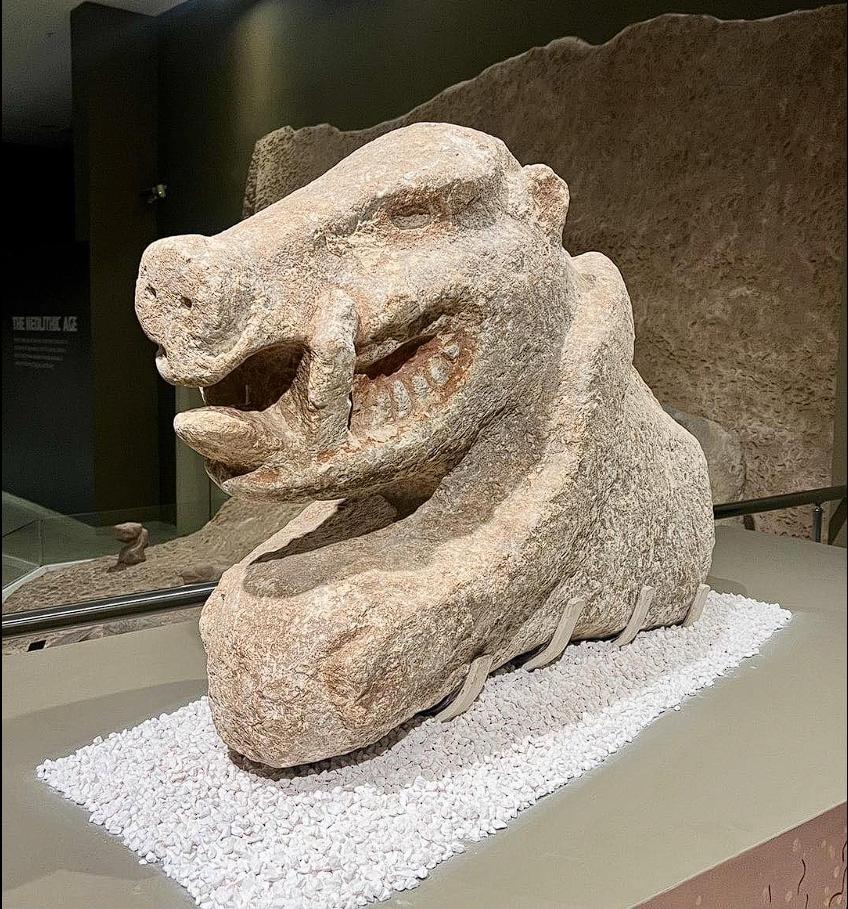“The unveiling of a life-sized pig sculpture at the Neolithic site of Göbekli Tepe in southeastern Turkey has provided an extraordinary glimpse into the artistic and ritualistic practices of early human societies. This remarkable artifact, dating back over 10,000 years, not only showcases the advanced craftsmanship of its creators but also offers a rare opportunity to understand the role of color in prehistoric art. Its discovery challenges our conventional understanding of the capabilities and complexity of communities transitioning from hunter-gatherers to settled agriculturalists.”

A Monumental Discovery: Unearthing the Past at Göbekli Tepe
- The Pig’s Form and Scale:
- The sculpture, meticulously carved to the actual size of a pig, likely a wild boar, stands as a testament to the artisans’ skill at Göbekli Tepe. Its realism and scale suggest a deep understanding of the animal’s form and a sophisticated artistic tradition.
- This level of detail and craftsmanship, particularly at such an early stage of human development, raises questions about the social organization and specialized labor required to produce such a piece.
- Preservation and Pigment:
- What makes this discovery truly exceptional is the survival of pigment on the sculpture’s surface. This rare preservation of color provides invaluable insight into the aesthetic preferences and artistic techniques of the people who created it.
- The presence of pigment indicates that these sculptures were not merely intended to be seen as stone objects but were meant to be experienced visually, potentially playing a role in ritualistic practices.
- The Pig’s Significance:
- The pig, a powerful presence in the lives of these early communities, likely held both practical and symbolic significance. It would have been a source of food, but also possibly a figure of ritual or symbolic importance.
- Understanding the pig’s role in their lives sheds light on the relationship between humans and animals in this transitional period, as agriculture began to take root.
Göbekli Tepe’s Legacy: Challenging Conventional Narratives
- Early Monumental Architecture:
- Göbekli Tepe, known for its monumental stone architecture, predates the development of settled agriculture. This site challenges the traditional view that complex societies and monumental construction arose only after the advent of farming.
- The pig sculpture further supports the notion that sophisticated artistic and ritualistic practices were present in early human communities, even before the establishment of sedentary lifestyles.
- Art and Ritual:
- The painted pig sculpture underscores the importance of art and ritual in the lives of these early people. It was not simply a decorative object but a component of a larger ritualistic landscape.
- The positioning of the sculpture within the site, its painted surface, and its life-sized scale suggest that it played a significant role in ceremonies or symbolic representations.
- A Lost World Revealed:
- Göbekli Tepe, with its intricate carvings and monumental structures, offers a window into a lost world, one that was far more complex and sophisticated than previously imagined.
- The painted pig sculpture, with its vibrant colors and realistic form, brings this world to life, reminding us that early humans possessed a rich artistic and cultural heritage.
Implications and Future Research: Unraveling the Neolithic Past
- Understanding Early Art:
- The discovery of preserved pigment on the pig sculpture opens up new avenues for research into the use of color in prehistoric art. Further analysis of the pigments used can provide insights into the materials and techniques employed by the artisans.
- This discovery may also lead to the reevaluation of other prehistoric sculptures, as it suggests that color may have been a more common feature than previously thought.
- Ritualistic Practices:
- The pig sculpture’s potential role in ritualistic practices raises questions about the beliefs and ceremonies of the people who inhabited Göbekli Tepe. Future research may focus on the context in which the sculpture was found and its relationship to other artifacts at the site.
- Understanding these rituals can shed light on the social organization and spiritual beliefs of early human communities.
- Göbekli Tepe’s Significance:
- Göbekli Tepe continues to challenge our assumptions about the timeline of human development. The painted pig sculpture adds another layer to this understanding, highlighting the artistic and cultural achievements of these early people.
- The site’s significance extends beyond its artistic value, offering insights into the transition from hunter-gatherers to settled agriculturalists and the emergence of complex societies.
Conclusion:
“The painted pig sculpture, unearthed at Göbekli Tepe, stands as a remarkable testament to the artistic and ritualistic capabilities of early human societies. Its realism, scale, and the preservation of pigment provide a unique window into a lost world, challenging conventional narratives about the timeline of human development. This discovery underscores the importance of Göbekli Tepe in reshaping our understanding of the Neolithic period and the complex cultural heritage of our ancestors.”

CÁC TIN KHÁC
Mary Walton: The Forgotten Inventor Who Helped Clean Up America’s Cities
Tomb of Queen Nefertari in the Valley of the Queens, Egypt
Discover the Hypostyle Hall of the Temple of Hathor at Dendera
Venus de Losange: Unveiling the Mystery of a 20,000-Year-Old Paleolithic Icon